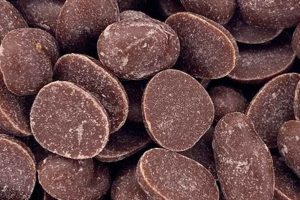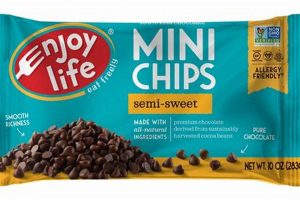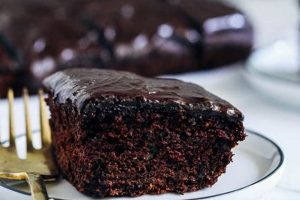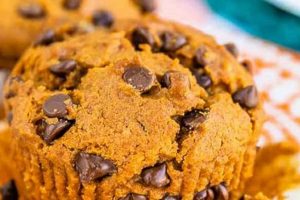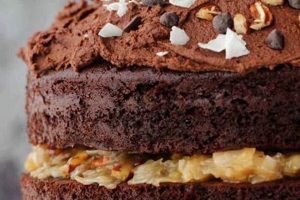A culinary creation, this breakfast dish combines the comforting familiarity of a classic pancake with the rich indulgence of cocoa, all while adhering to plant-based dietary principles. This means it contains no animal-derived ingredients such as eggs, dairy milk, or butter, instead relying on plant-based alternatives like almond milk, flaxseed meal, or mashed banana to achieve the desired texture and flavor. One could find this dish served with fresh berries, maple syrup, or a dusting of cocoa powder for an enhanced experience.
The rising popularity of plant-based diets has fueled the demand for such innovative adaptations of traditional recipes. These modifications allow individuals adhering to veganism or those seeking to reduce their consumption of animal products to enjoy beloved treats without compromising their ethical or health-related choices. Furthermore, the creation of these breakfast items can reduce the environmental impact associated with animal agriculture, contributing to a more sustainable food system. Recipes for this type of pancake have begun appearing more frequently in cookbooks and online culinary platforms, reflecting their growing acceptance and appeal.
The following sections will delve into various aspects relevant to creating and enjoying these dishes, from ingredient selection and preparation techniques to nutritional considerations and potential variations.
Crafting Superior Vegan Chocolate Pancakes
Achieving optimal results when preparing this breakfast item requires careful attention to detail and ingredient selection. These tips provide guidance for a successful outcome.
Tip 1: Employ High-Quality Cocoa Powder: The depth of chocolate flavor is directly proportional to the quality of cocoa used. Opt for Dutch-processed cocoa powder for a richer, less acidic taste.
Tip 2: Utilize Plant-Based Milk with Sufficient Fat Content: Almond, soy, or oat milk work well, but ensure they are not overly watered down. The fat content contributes to a tender crumb.
Tip 3: Incorporate a Binding Agent: Flaxseed meal mixed with water (a “flax egg”) or mashed banana serves as an effective binder, replacing the function of eggs in traditional recipes. One tablespoon of flaxseed meal mixed with three tablespoons of water, allowed to sit for five minutes, is generally sufficient for one batch of pancakes.
Tip 4: Avoid Overmixing the Batter: Overmixing develops gluten, leading to tough pancakes. Mix the wet and dry ingredients until just combined, leaving some lumps.
Tip 5: Use a Properly Heated and Lightly Oiled Griddle or Pan: The ideal temperature ensures even cooking and prevents sticking. A light coating of vegan butter or oil is recommended.
Tip 6: Exercise Patience During Cooking: Allow the pancakes to cook undisturbed until bubbles form on the surface and the edges begin to set before flipping. This typically takes 2-3 minutes per side.
Tip 7: Introduce Chocolate Chips Strategically: Adding vegan chocolate chips directly to the batter can cause them to sink to the bottom. Consider gently pressing them into the pancakes once they are on the griddle.
These guidelines contribute to the creation of flavorful, tender, and visually appealing vegan chocolate pancakes, enhancing the overall dining experience.
The following section will explore recipe variations and serving suggestions.
1. Cocoa Powder Quality
The selection of cocoa powder exerts a significant influence on the resulting flavor profile and overall quality of vegan chocolate pancakes. Cocoa powder, derived from cocoa solids, imparts the characteristic chocolate taste. The type of cocoa powder employednatural or Dutch-processeddirectly impacts the acidity, bitterness, and intensity of the chocolate flavor in the final dish. Natural cocoa powder, being more acidic, can react with baking soda present in pancake recipes, contributing to leavening. In contrast, Dutch-processed cocoa powder undergoes an alkalization process, which reduces acidity and bitterness, yielding a smoother, richer flavor. Therefore, using higher-quality cocoa powder translates directly into a more refined and palatable final product. For instance, substituting a generic, inexpensive cocoa powder with a single-origin, high-fat cocoa powder will elevate the pancakes from a standard breakfast item to a more gourmet experience.
The impact of cocoa quality extends beyond mere taste. The inherent properties of different cocoa powders influence texture and appearance. High-fat cocoa powders can contribute to a moister, more tender pancake. Furthermore, the color of the cocoa powder influences the final color of the pancakes. Darker, higher-quality cocoa powders often produce pancakes with a deeper, more appealing chocolate hue. From a practical standpoint, individuals developing recipes for this breakfast staple frequently experiment with various cocoa powders to achieve a desired flavor balance and aesthetic appeal. Professional bakers understand the importance of cocoa powder selection and often rely on specific brands or blends to ensure consistency in their final products. For example, a baker aiming for a deep, dark chocolate flavor may choose a blend of Dutch-processed and black cocoa powder, whereas a baker seeking a milder, more traditional chocolate flavor might opt for a standard Dutch-processed variety.
In summary, the quality of cocoa powder functions as a fundamental determinant of the taste, texture, and appearance of the recipe. The conscious choice of the appropriate cocoa powder can elevate the pancakes, offering a deeper flavor and enhancing the sensory experience. This seemingly small detail has a profound impact on the final product, justifying the investment in higher-quality cocoa. Neglecting this ingredient aspect could result in a bland or underwhelming breakfast, a result that underscores the importance of thoughtful cocoa selection.
2. Plant-Based Milk Choice
The selection of plant-based milk exerts a significant influence on the final texture, flavor, and overall success of vegan chocolate pancakes. Plant-based milks serve as a crucial liquid component, replacing dairy milk in traditional pancake recipes. The specific characteristics of each plant-based milk option affect the batter’s consistency, the pancakes’ tenderness, and the subtle flavor nuances of the finished product. For instance, oat milk, due to its higher starch content, tends to produce a slightly chewier pancake with a subtly sweet flavor. Conversely, almond milk, with its lower fat and carbohydrate content, may result in a lighter, less dense pancake. Soy milk, with its relatively high protein content, can contribute to a slightly more robust texture. The choice directly impacts the structural integrity and palatability of the final dish.
The fat content, protein levels, and sugar presence in a chosen plant-based milk determine its suitability for pancake preparation. Higher fat content, such as that found in certain oat milk brands or full-fat coconut milk (though the latter imparts a distinct coconut flavor), tends to contribute to a more tender and moist pancake. Protein plays a role in gluten development (in recipes where gluten-containing flour is used) and browning. Higher sugar content can influence the speed at which the pancakes brown and caramelize on the griddle. These factors, when considered in relation to the other ingredients in a vegan chocolate pancake recipe, allow for fine-tuning the overall outcome. Examples include adjusting the amount of leavening agent based on the acidity of the plant-based milk, or modifying the added sugar content based on the natural sweetness of the selected milk.
The careful selection of plant-based milk is a critical component in achieving desirable characteristics. The understanding of how each milk alternative functions within the recipe allows for greater control over the texture, flavor, and appearance of the vegan chocolate pancakes. The successful execution of this breakfast item hinges on recognizing that not all plant-based milks are interchangeable, and the selection should be thoughtfully aligned with the desired result. The choice should therefore be made based on the properties of the specific product and its contribution to the intended texture and taste profile of the finished pancake.
3. Binding Agent Effectiveness
The structural integrity and overall texture of vegan chocolate pancakes are significantly influenced by the effectiveness of the binding agent employed. In traditional pancake recipes, eggs provide this crucial binding function. However, vegan recipes necessitate plant-based alternatives that can replicate the binding properties of eggs, holding the ingredients together and preventing the pancakes from crumbling during cooking.
- Flaxseed Meal as a Binding Agent
Flaxseed meal, when mixed with water, forms a gelatinous substance often referred to as a “flax egg.” This mixture mimics the binding properties of eggs due to the soluble fiber present in flaxseeds. The flaxseed meal hydrates and creates a sticky consistency, effectively holding the dry and wet ingredients together. In the absence of a sufficient binding agent, the pancakes may become crumbly and difficult to flip. Furthermore, the “flax egg” has a subtle nutty flavor that complements chocolate.
- Mashed Banana as a Binding Agent
Mashed banana is another viable binding agent, contributing both moisture and sweetness. The natural starches in banana help to bind the ingredients, providing a tender texture. However, the flavor of banana is more pronounced than that of flaxseed meal, which may alter the overall flavor profile of the chocolate pancakes. If using mashed banana, careful attention must be paid to balancing the sweetness and ensuring that the banana flavor does not overpower the chocolate.
- Commercial Egg Replacers
Several commercially available vegan egg replacers exist, often formulated with a blend of starches, tapioca flour, and other plant-based ingredients. These replacers are designed to mimic the functional properties of eggs in baking and can provide reliable binding in vegan chocolate pancakes. It’s imperative to select an egg replacer that is specifically intended for binding rather than leavening, as some replacers are formulated primarily for lift.
- Chia Seeds as a Binding Agent
Similar to flax seeds, chia seeds can be used to create a binding gel when mixed with water. Chia seeds possess a high soluble fiber content, enabling them to absorb liquid and form a thick, viscous mixture. While effective as a binding agent, the texture of chia seeds can be slightly noticeable in the final product. Finely ground chia seeds can minimize this texture issue. Like flax seeds, chia seeds contribute a mild, nutty flavor that generally complements the chocolate profile of the pancakes.
The successful execution of vegan chocolate pancakes depends on the effective employment of a binding agent. Each option possesses distinct properties that influence the final texture and flavor. The judicious selection and appropriate usage of the binding agent ensure that the pancakes hold together, creating a visually appealing and texturally satisfying final product. The impact of the binding agent is crucial, underlining the significance of selecting an option that harmonizes with the desired characteristics of the finished pancakes.
4. Batter Mixing Technique
The batter mixing technique employed in the preparation of vegan chocolate pancakes exerts a substantial influence on the final texture, tenderness, and overall palatability of the finished product. The manner in which wet and dry ingredients are combined directly impacts gluten development (in recipes containing gluten), air incorporation, and the uniformity of the batter. Improper mixing can result in either excessively dense or overly tough pancakes, thereby diminishing the overall quality of the dish.
- Minimizing Gluten Development
Overmixing a batter containing gluten-based flour (such as wheat flour) leads to excessive gluten development. Gluten, a protein complex, forms a network that imparts elasticity to doughs. While desirable in bread making, excessive gluten development in pancake batter results in tough, chewy pancakes. To mitigate this, the mixing process should be curtailed, ceasing when the wet and dry ingredients are just combined. A few lumps in the batter are acceptable and preferable to overmixing.
- Incorporating Air for Lightness
The gentle incorporation of air into the batter contributes to a lighter, more tender texture. This is often achieved through the initial whisking of wet ingredients or the careful folding of wet and dry components. Vigorous mixing, however, can deflate the batter, resulting in dense, flat pancakes. The technique should aim to introduce and retain air bubbles within the batter matrix without overworking the ingredients.
- Ensuring Uniform Ingredient Distribution
Proper mixing ensures that all ingredients, including cocoa powder, leavening agents (baking powder or baking soda), and chocolate chips (if used), are evenly distributed throughout the batter. Inadequate mixing can lead to pockets of concentrated flavor or uneven leavening, resulting in inconsistencies in taste and texture across individual pancakes. A gentle but thorough mixing action is essential to achieve uniformity.
- Mixing Order and Temperature
The sequence in which ingredients are combined can also affect the outcome. Generally, it’s advisable to mix dry ingredients separately before adding them to the wet ingredients. This helps to prevent clumps of dry ingredients from forming in the batter. In some cases, using slightly warm (but not hot) plant-based milk can aid in the dissolution of cocoa powder and enhance the activation of leavening agents. However, excessively warm liquids can prematurely activate the leavening, leading to a loss of rise during cooking.
The interplay of these facets dictates the final product’s texture, flavor, and visual appeal. A properly executed mixing technique, characterized by minimal gluten development, gentle air incorporation, uniform ingredient distribution, and attention to mixing order and temperature, is crucial for producing tender, light, and evenly flavored vegan chocolate pancakes. Failure to adhere to these principles can compromise the quality of the dish, underscoring the importance of meticulous attention to the batter mixing process.
5. Griddle Temperature Control
Griddle temperature control is a critical determinant of the quality of vegan chocolate pancakes. Temperature regulation dictates the rate of Maillard reaction, a chemical process responsible for browning and the development of complex flavors. Inadequate heat causes pancakes to spread excessively, becoming thin and pale, while excessive heat results in scorching and an undercooked interior. Vegan pancakes, often lacking the structural support provided by eggs in traditional recipes, are particularly susceptible to these temperature-related issues.
Proper temperature management ensures even cooking and prevents sticking. A griddle that is too cool fails to properly set the batter, leading to pancakes that adhere to the surface and tear upon attempted flipping. Conversely, an excessively hot griddle causes the pancake surface to burn before the interior has a chance to cook through. A moderate, consistent temperature (typically around 350-375F or 175-190C) allows for uniform browning and thorough cooking. The use of an infrared thermometer provides a reliable method for verifying the griddle temperature. Real-world examples highlight the practical significance of this control: a restaurant consistently serving well-browned, evenly cooked vegan chocolate pancakes relies on calibrated griddles and trained staff to monitor temperature meticulously. Conversely, home cooks experiencing inconsistent results often find that improving temperature control significantly enhances their pancake outcomes.
In conclusion, griddle temperature control is non-negotiable for producing high-quality vegan chocolate pancakes. Attaining the correct temperature not only ensures proper cooking but also contributes to the desired flavor and texture. While challenges may arise in maintaining a consistent temperature, particularly on stovetop griddles, the investment in appropriate tools and techniques yields demonstrable improvements in the final product. A comprehensive understanding of temperature’s role in pancake preparation is, therefore, essential for consistently achieving optimal results.
6. Cooking Patience Required
The preparation of vegan chocolate pancakes necessitates a degree of patience that surpasses that often required for conventional pancakes. The absence of eggs and dairy, crucial binding and emulsifying agents, alters the cooking dynamics. Consequently, vegan pancakes tend to cook at a slower pace and require a more attentive approach to prevent burning or undercooking. A rushed process frequently leads to unevenly cooked pancakes, characterized by scorched exteriors and doughy interiors.
One of the primary reasons this breakfast item demands patience lies in the need for precise temperature control. Vegan pancakes often contain higher moisture content from plant-based milk and binding agents like flaxseed meal or mashed banana. This increased moisture requires a longer cooking duration at a moderate heat to ensure complete evaporation and structural solidification. A common error is increasing the heat to expedite the cooking process, which invariably results in a burnt surface and an uncooked center. Experienced cooks understand the importance of allowing the pancakes to cook undisturbed until bubbles form on the surface and the edges begin to set, a visual cue that indicates readiness for flipping. Rushing this stage leads to tearing and sticking, compromising the pancake’s structural integrity. Consider, for example, a novice cook who, impatient for breakfast, increases the griddle temperature, resulting in blackened, gooey pancakes. Conversely, a seasoned vegan baker knows that a patient approach, allowing the pancakes to cook slowly and evenly, produces a perfectly golden-brown, fluffy result.
The patient approach extends beyond mere cooking time. After mixing the batter, allowing it to rest for a short period (5-10 minutes) enables the ingredients to fully hydrate, resulting in a smoother, more consistent texture. Furthermore, the gentler handling of the batter during pouring and flipping, born from a patient mindset, prevents deflation and ensures a light, airy final product. The creation of acceptable vegan chocolate pancakes is closely correlated with patience and focus. Rushing the process will invariably result in suboptimal results, which will result in burnt or unevenly cooked pancakes. This approach also allows for a superior outcome and will ultimately result in a superior dining experience for everyone.
7. Chocolate Chip Placement
The strategic distribution of chocolate chips within vegan chocolate pancakes significantly impacts the texture, flavor, and overall enjoyment of the final product. Consistent placement ensures a balanced distribution of chocolate throughout each pancake, preventing localized concentrations of sweetness or bitterness, thereby optimizing the eating experience.
- Even Distribution for Flavor Balance
Strategic placement of chocolate chips ensures each bite contains a proportionate amount of chocolate. Concentrated pockets of chocolate can overwhelm the palate, while uneven distribution leaves some areas lacking the intended flavor. For instance, sprinkling chocolate chips evenly over the surface of the pancake batter on the griddle, rather than mixing them directly into the batter, promotes a more balanced flavor profile across the entire surface.
- Preventing Sinking During Cooking
Chocolate chips, due to their density, tend to sink to the bottom of the batter during cooking. This results in a bottom-heavy distribution of chocolate and can lead to burning on the griddle. To mitigate this, adding the chips to the pancake only after pouring the batter onto the griddle allows for controlled placement and minimizes sinking. One can also use smaller chocolate chips, as they tend to disperse more evenly and are less prone to sinking.
- Visual Appeal and Texture
The aesthetic appeal of vegan chocolate pancakes is enhanced by thoughtfully placed chocolate chips. A visually appealing pancake often has chocolate chips strategically placed near the surface, creating an inviting presentation. In terms of texture, the contrast between the soft pancake and the slightly firm chocolate chips contributes to a more enjoyable sensory experience.
- Impact of Batter Consistency
The consistency of the batter directly affects chocolate chip placement. Thicker batters provide more support, reducing the likelihood of sinking. Thinner batters require more careful placement, perhaps pressing the chips gently into the surface to ensure they remain visible and well-distributed. Real-world bakeries that specialize in plant-based baked goods understand this interplay and adjust their batter consistency accordingly to achieve optimal chocolate chip distribution.
In summation, chocolate chip placement is a subtle yet critical aspect of vegan chocolate pancake preparation. Through mindful placement, these elements collectively optimize the textural and aesthetic qualities of a simple breakfast item. Mastery of this seemingly small detail can elevate the overall quality of vegan chocolate pancakes, contributing significantly to consumer satisfaction.
Frequently Asked Questions
This section addresses common inquiries regarding the preparation, ingredients, and variations of vegan chocolate pancakes, providing concise and informative answers.
Question 1: Can all types of flour be used interchangeably in vegan chocolate pancake recipes?
No. Different flours possess varying protein and starch contents, affecting texture and structure. Gluten-free flours, for instance, require binding agents due to the absence of gluten. Recipes are typically formulated for specific flour types; substituting may necessitate adjustments to liquid or binding agent quantities.
Question 2: Is the use of a non-stick griddle essential for successful vegan chocolate pancake preparation?
While not strictly essential, a non-stick griddle significantly reduces the likelihood of sticking, minimizing the need for excessive oil and facilitating easier flipping. Alternatively, a well-seasoned cast iron griddle can be used, ensuring proper preheating and greasing.
Question 3: What is the best method for preventing vegan chocolate pancakes from becoming gummy or dense?
Overmixing the batter leads to gluten development (when using gluten-based flours) resulting in a dense texture. Mix until just combined, leaving some lumps. Ensure baking powder or baking soda are fresh, as expired leavening agents fail to provide sufficient lift.
Question 4: How does the type of plant-based milk affect the flavor and texture of vegan chocolate pancakes?
Plant-based milks contribute varying degrees of sweetness and fat content. Oat milk, for example, often yields a slightly sweeter and chewier pancake due to its higher carbohydrate content. Almond milk provides a lighter texture. The selection should align with the desired flavor and texture profile.
Question 5: What are suitable substitutes for chocolate chips in vegan chocolate pancakes?
Alternatives include chopped nuts, dried fruit (such as cranberries or cherries), or a drizzle of melted vegan chocolate. Cocoa nibs can also impart a chocolate flavor without adding sweetness.
Question 6: Can vegan chocolate pancakes be prepared in advance and reheated?
Yes. Pancakes can be stored in an airtight container in the refrigerator for up to three days. Reheating options include a microwave (though this may result in a slightly softer texture), a toaster, or a dry skillet on low heat. Freezing is also an option; however, defrosting before reheating is recommended.
This overview provides a concise understanding of the factors influencing the successful preparation and enjoyment of vegan chocolate pancakes.
The subsequent section will explore recipe variations and creative serving suggestions.
Conclusion
This exploration of vegan chocolate pancakes has illuminated critical facets of their creation and enjoyment. From the nuanced selection of cocoa powder and plant-based milk to the essential roles of binding agents, mixing techniques, and temperature control, the elements that contribute to a superior final product have been thoroughly examined. The strategic placement of chocolate chips and the necessity for patience during cooking were also emphasized, underscoring the attention to detail required for optimal results.
The information presented serves as a foundation for both novice and experienced cooks seeking to master this plant-based adaptation of a classic breakfast item. The consistent application of the principles outlined within these sections will result in an improved dining experience. As plant-based diets continue to evolve, the refinement of recipes like this remains crucial, promoting accessible and satisfying options for a growing demographic.



